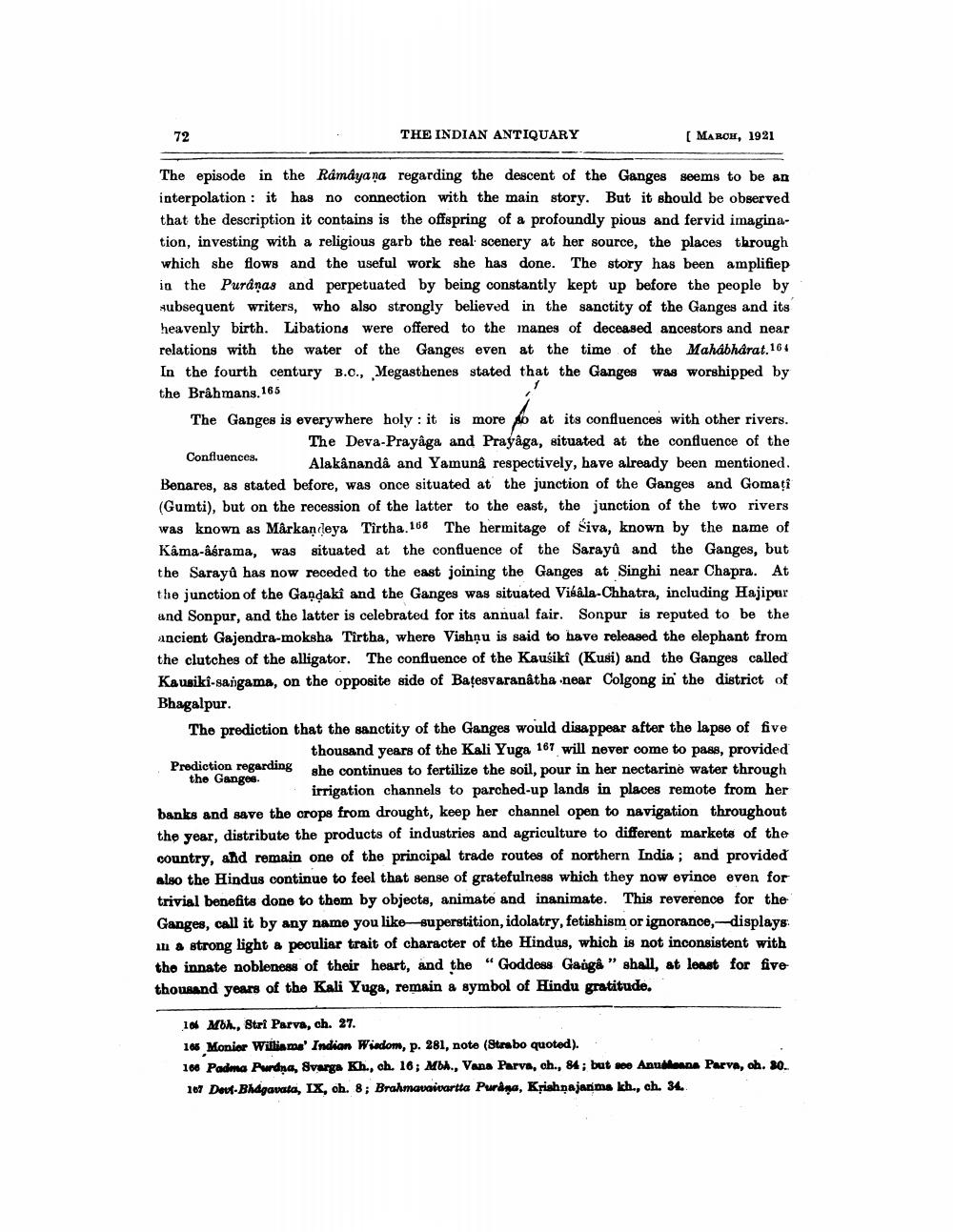________________
72
THE INDIAN ANTIQUARY
( MABOH, 1921
The episode in the Ramayana regarding the descent of the Ganges seems to be an interpolation : it has no connection with the main story. But it should be observed that the description it contains is the offspring of a profoundly pious and fervid imagination, investing with a religious garb the real scenery at her source, the places through which she flows and the useful work she has done. The story has been amplifiep in the Puranas and perpetuated by being constantly kept up before the people by subsequent writers, who also strongly believed in the sanctity of the Ganges and its heavenly birth. Libations were offered to the inanes of deceased ancestors and near relations with the water of the Ganges even at the time of the Mahabharat 164 In the fourth century B.C., Megasthenes stated that the Ganges was worshipped by the Brâhmang.165 The Ganges is everywhere holy: it is more po at its confluences with other rivers.
The Deva-Prayaga and Prayaga, situated at the confluence of the Confluences.
Alakânandâ and Yamuna respectively, have already been mentioned. Benares, as stated before, was once situated at the junction of the Ganges and Gomati (Gumti), but on the recession of the latter to the east, the junction of the two rivers was known as Markandeya Tirtha. 166 The hermitage of Siva, known by the name of Káma-asrama, was situated at the confluence of the Sarayů and the Ganges, but the Sarayű has now receded to the east joining the Ganges at Singhi near Chapra. At the junction of the Gandaki and the Ganges was situated Vikala-Chhatra, including Hajipur and Sonpur, and the latter is celebrated for its annual fair. Sonpur is reputed to be the ancient Gajendra-moksha Tirtha, where Vishnu is said to have released the elephant from the clutches of the alligator. The confluence of the Kaušiki (Kusi) and the Ganges called Kausiki-sangama, on the opposite side of Batesvaranátha near Colgong in the district of Bhagalpur. The prediction that the sanctity of the Ganges would disappear after the lapse of five
thousand years of the Kali Yuga 167 will never come to pass, provided Prediction regarding she continues to fertilize the soil, pour in her nectarine water through the Ganges.
irrigation channels to parched-up lands in places remote from her banks and save the crops from drought, keep her channel open to navigation throughout the year, distribute the products of industries and agriculture to different markets of the country, and remain one of the principal trade routes of northern India, and provided also the Hindus continue to feel that sense of gratefulness which they now eyince even for trivial benefits done to them by objects, animate and inanimate. This reverence for the Ganges, call it by any name you like superstition, idolatry, fetishism or ignorance,-displays m a strong light a peculiar trait of character of the Hindus, which is not inconsistent with the innate nobleness of their heart, and the “Goddess Gangå ” shall, at least for five thousand years of the Kali Yuga, remain a symbol of Hindu gratitude.
10 Mh., Stri Parva, ch. 27. 106 Monior Williams' Indian Wisdom, p. 281, note (Strabo quoted). 166 Padma Purdņa, Svarga Kh., ch. 16; M ., Vana Parva, ch., 84; but soe Anubhaana Parva, oh. 80. 107 Deut-Bhagavata, LX, oh. 8; Brahmavaivartta Purana, Krishnajanma kch., ch. 34.




